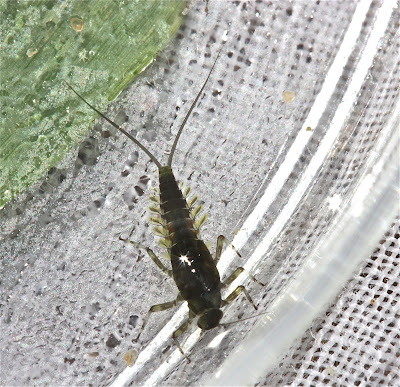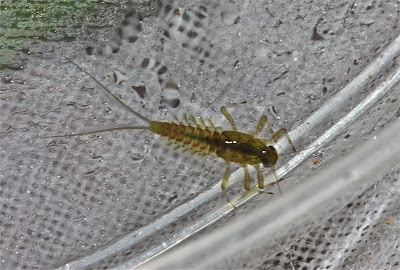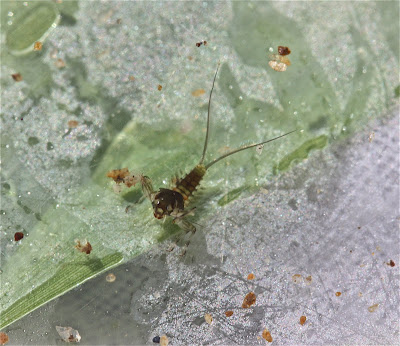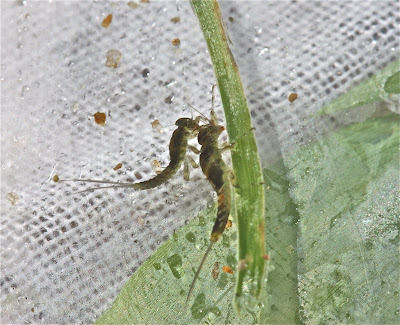We can find flatheaded mayflies (family Heptageniidae) in most of our streams just about every month of the year -- if not every month of the year. And they're easy to find because they're "clingers," i.e. they feed by clinging to rocks and eating the algae. So when you're looking for them, simply turn over some rocks.
As I've mentioned in previous entries, I've found -- to date -- six genera of flatheaded mayflies in this part of Virginia:
Maccaffertium (formerly
Stenonema),
Stenacron,
Epeorus (both
pleuralis and
vitreus),
Rhithrogena,
Heptagenia, and
Leucrocuta.
Maccaffertium nymphs seem to be here most of the year, all of the rest seem to be limited to certain seasons. But as a fly fisherman who grew up looking forward to the "March Brown" (
Stenonema vicarium) hatch every spring and the Light Cahill (
Stenonema Ithica) hatch in the summer, I've started to wonder how the nymphs that I'm finding fit into the major hatches that are important to fly fisherman.
In this entry, I'd like to pull together data from three different sources, and we'll see what we see: I can't guarantee this will answer all of my questions. Still, it will be nice for me -- and presumably others -- to have this data all together in one location. My three sources of data will be:
1) My own records of the genera I've found and when I've found them. When did I first see nymphs of certain genera? By when were they mature? (Naturally, dates vary from stream to stream.)
2) For the major hatches known to fly fishermen, and the flatheaded species known to produce them, I'll rely on the masterful study of mayflies -- Malcolm Knopp and Rober Cormier,
Mayflies: An Angler's Study of Trout Water Ephemeroptera (Helena, MT: Greycliff Publishing Co., 1997).
3) And for information on the number of flatheaded species -- by genus -- that we find in this part of the country, I'll be using the "Tolerance Values for Benthic Macroinvertebrates," developed by the North Carolina Division of Water Quality. This can be found at: http://portal.ncdenr.org/web/wq/ess/bau.
(Note: This is a detailed and technical entry; some of you might want to skip it.)
1. Let's take an easy one first: the genus Rhithrogena.
a) My first sighting of a
Rhithrogena nymph was on April 25 (Buck Mt. Creek), and my last sighting was on May 9 (the nymph in the picture above). I'm sure there were nymphs in this stream and others before and after those dates, but these are the only days that I found them.
b) Knopp and Cormier (p. 137) list four
Rhithrogena species that are important out West, producing the "Western March Browns," with hatch dates running -- in general -- from Mid-March through Mid-May.
They do not see this genus as important for fly fishermen in the East. They state, "Scattered populations of
Rhithrogena species also inhabit certain East and Midwest freestone rivers but are not known to produce very reliable hatches." (p. 137) The only place I've seen nymphs of this genus is Buck Mt. Creek, and even there I've seen only a few.
c) There are 5
Rhithrogena species documented by the NC Division of Water Quality. None of these corresponds to the important species out West (which are
R. morrisoni,
R. hageni,
R. undulata, and
R. futilis.) Three of the Eastern species in the NC list have a tolerance value of 0.0; the other two are undetermined.
__________
2. Maccaffertium (known to fly fisherman by its former name -- Stenonema) -- see the photo at the top of the page.
a) This is the big one. The first time I spotted a
Maccaffertium nymph this year was on February 11th at Lickinghole Creek in Crozet. The one in the photo at the top of this page was found on March 28th at Powells Creek in Crozet (close to being mature). Then I found one with black wing pads just last week at the Moormans (see entry for 6/15), but I continue to find pretty big
Maccaffertium nymphs that are still not mature. This one was found Powells Creek on 6/21.
Were any of the nymphs I found early on in the spring
Maccaffertium/Stenonema vicarium (the "March Brown")? Will the large nymphs I'm finding now grow into "Light Cahills" (
Maccaffertium/Stenonema ithaca)? Sure wish I could answer those questions.
b) Knopp and Cormier (p. 176) list 7
Stenonema (i.e. Maccaffertium) species that produce key hatches here in the East:
S. vicarium (1.5),
S. femoratum (6.9),
S. modestum (5.7),
S. ithaca (3.0),
S.mediopunctatum (4.2),
S. mexicanum integrum (4.7), and
S. pulchellum (undetermined).
All of these species are present in our area based on the list published in North Carolina (tolerance values are listed in parentheses). These species produce the following hatches:
S. vicarium -- "American March Brown" (mid-May through mid-July);
S. ithaca -- "Gray Fox" and "Light Cahill" (mid-June through mid-August);
S. pulchellum,
S. modestum,
S. mexicanum integrum,
S. femoratum, and
S. mediopunctatum -- the "Cream Cahill" (end of May through mid-September). (Knopp and Cormier, pp. 176-185.)
c) Additional
Maccaffertium (=
Stenonema) species reported for our area by the NC Division of Water Quality are:
M. carlsoni (2.1),
M. exiguum (3.8),
M. lenati (2.5),
M. meririvulanun (0.5),
M. pudicum (2.1) and
M. terminatum (4.4).
__________
3. Stenacron.
Earliest sighting and latest sighting. 3/18: Whippoorwill Branch
6/16: Mechunk Creek
a) In the 2-3 years I've been looking for insects, I've found very few
Stenacron nymphs. This year I found one at Whippoorwill Branch, one at Ballinger Creek (on 5/14), one at the Moormans (6/15), and this fully mature nymph at the Mechunk. I think they're rare in our streams.
b) Knopp and Cormier (pp. 186-187) say that of the seven species in North America only
Stenacron interpunctatum is important for fly fisherman. It too hatches as a "Light Cahill," the hatch peaking "between mid-June and mid-July".
c) The North Carolina Division of Water Quality lists 4 species found in this region:
S. carolina (1.3),
S. interpunctatum (6.4),
S. pallidum (2.8), and
S. spp (unidentified species; undetermined TV).
__________
4. Epeorus. The North Carolina list of tolerance values has 5 species of
Epeorus mayflies. I've only seen two in our area --
Epeorus pleuralis (TV of 1.5) and
Epeorus vitreus (TV of 1.2) -- and I'll treat them separately. Knopp and Cormier (p. 159) provide hatch information for 5 species (but not the same 5 recognized in North Carolina, with the exception of
pleuralis and
vitreus).
4A. Epeorus pleuralis.
a) Well known to fly fishermen, this produces the "Quill Gordon" (also "Slate Duns") hatch in the spring. This year, my first sighting of
Epeorus pleuralis was on January 2nd. This is one of the photos I took.
My last sighting -- at least the last sighting I can document with my photos -- was on 4/20. But I had earlier (3/24) found this mature nymph at the Rapidan River.
b) Knopp and Cormier (p. 159) give a hatch range of mid-April to mid-June for
Epeorus pleuralis. But a lot of Eastern hatch data is based on when things occur in New England. So, the hatch might start at the beginning of April here in VA.
c) The North Carolina tolerance value for
Epeorus pleuralis, as I've already noted, is 1.5.
4B. Epeorus vitreus ("Gray-winged Yellow Quill")
a) My first photo of an
E. vitreus nymph was taken on 5/11, my lastest (below) on 6/10. Both nymphs were found in Buck Mt. Creek.
I'm finding
E. vitreus in some of the same streams in which I found
E. pleuralis in the winter. But, I have not found them in the small, rocky tribs to the Moormans that were earlier loaded with
E. pleuralis nymphs.
b) Knopp and Cormier (p. 161) point out that "...
E. pleuralis and
E. vitreus may be separated by differences in gill structure, habitat preference, the shape of the insect's femoral flange, and the presence of paired spots marking the tergites [dorsal abdominal segments] of
E. vitreus nymphs." The paired spots on
E. vitreus nymphs can be seen in the photo above, and if you compare the gills of the
E. pleuralis and
E. vitreus nymphs, you can see the large vein patterns in the latter. As for the femoral flange, the
E. vitreus flange comes to a sharp point. This we can see in the microscope photo below.
They give a hatch range for
E. vitreus in the East of mid-May through mid-August.
c)
E. vitreus has a tolerance value of 1.2.
5. Heptagenia and 6. Leucrocuta. The "Pale Evening Dun" and "Gray Fox".
b) Let me go out of order on this one, since these two genera produce the same adults -- from the fly fishing point of view. Knopp and Cormier (p. 149) begin their discussion by noting "This complex contains the important mayflies of the closely related genera
Heptagenia,
Leucrocuta and
Nixe that populate the slow- to moderate-flowing reaches of cool, unpolluted trout streams and rivers across North America." They continue, "Entomologists have catalogued twenty-one species of this complex from East-Midwest waters, where
Leucrocuta hebe is the principal species to produce fishable hatches; on eastern waters,
H. pulla and
L. aphrodite are the major species producing fishable hatches." On dates of emergence they state, "
Leucrocuta aphrodite is the first of the eastern species of this complex to emerge in early May and produces minor sporadic hatches for several week. Following about two weeks later,
Heptagenia pulla begins its emergence, producing hatches of minor importance through the period of mid-May to August. On East and Midwest waters,
Leucrocuta hebe is an important hatch from July to early October."
a) This summer, I have not yet found any
Heptagenia nymphs -- believe me, I'm looking! I found a good number of them in August last year -- and they were pretty mature -- in the Moormans River. Thus, the only picture that I can show you is of a preserved nymph from last year. I certainly don't know if this is
H. pulla, but this does look pretty well ready to hatch.
On
Leucrocuta nymphs, I found one as early as January 6, and I have other photos from 3/21, 5/9, 6/15, and 6/18. Significant numbers of
Leucrocuta nymphs are now present on rocks: before June, my sightings were more sporadic. Could it be that the nymphs I saw in winter and early spring were
L. aphrodite, while the ones I'm finding now are
L. hebe, the species that hatches from July to October?
Here are my photos from 1/6 and 6/18 -- both nymphs are from Buck Mt. Creek.
c) The North Carolina list of tolerance values documents four
Heptagenia species for this area and three
Leucrocutas. They are:
Heptagenia julia (TV undetermined),
Heptagenia marginalis (2.2),
Heptagenia pulla (2.2), and
Heptagenia spp (1.9); then,
Leucrocuta aphrodite (2.9),
Leucrocuta hebe (TV undetermined), and
Leucrocuta spp (2.0).
The other flatheaded genus that we find in this "complex" --
Nixe -- is one that I've found in Montana, but I've never found one in our streams. There
is one
Nixe species --
Nixe spp -- in the North Carolina list of tolerance values, but the TV is undetermined.



















































